admin
Staff member
Shark Ridill 1.2 Full Face Helmet Review Summary
Review Summary
Shark’s entry level full-face helmet brings a lot to the party for its sub $200 (USD) price with very good build quality, a drop-down visor, and clear visibility through said visor. However, just average noise levels and “fair” ventilation leave it up against stiff competition such as the Scorpion EXO-420 which is a bit lower in price.
Build Quality
Sizing & Comfort
Visibility
Ventilation
Noise
Safety
Weight
Pros
Good quality build (mostly)
Low distortion main visor
Pinlock®-ready visor
Micro-metric strap fastener*
Cons
Drop-down visor mechanism placement
No chin curtain
Below average ventilation
Micro-metric strap fastener
3.6
Average, With Drawbacks
Shark Ridill 1.2 Full Face Helmet Image Gallery
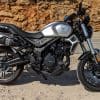



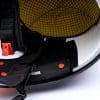

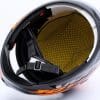

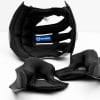



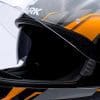

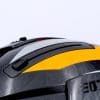

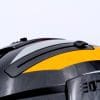

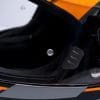

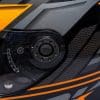

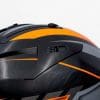

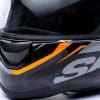

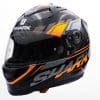

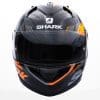

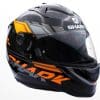

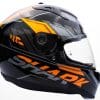

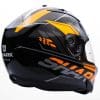

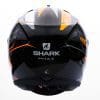

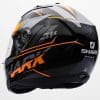

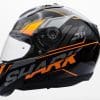

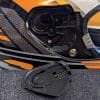

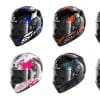

Buy Now
RevZillaTroy Lee Designs
For those of you who are long-time readers of WebBikeWorld, you may have noticed I have been absent for a while. Over the past year I have retired, sold our home in Tennessee, and moved to Valencia, Spain. For most of 2022 I didn’t even have a motorcycle to ride, so that precluded reviewing things motorcycle related.
Now that I’ve gotten settled here, I have started taking the steps to getting back to riding and since I sold almost all of my gear, I of course needed to make some purchases which included a helmet. I wanted to purchase a new lid from a “known quantity” and not spend too much money at this point, so when I arrived at the nearby moto shop, I naturally gravitated to one of my favorite helmet brands, Shark.
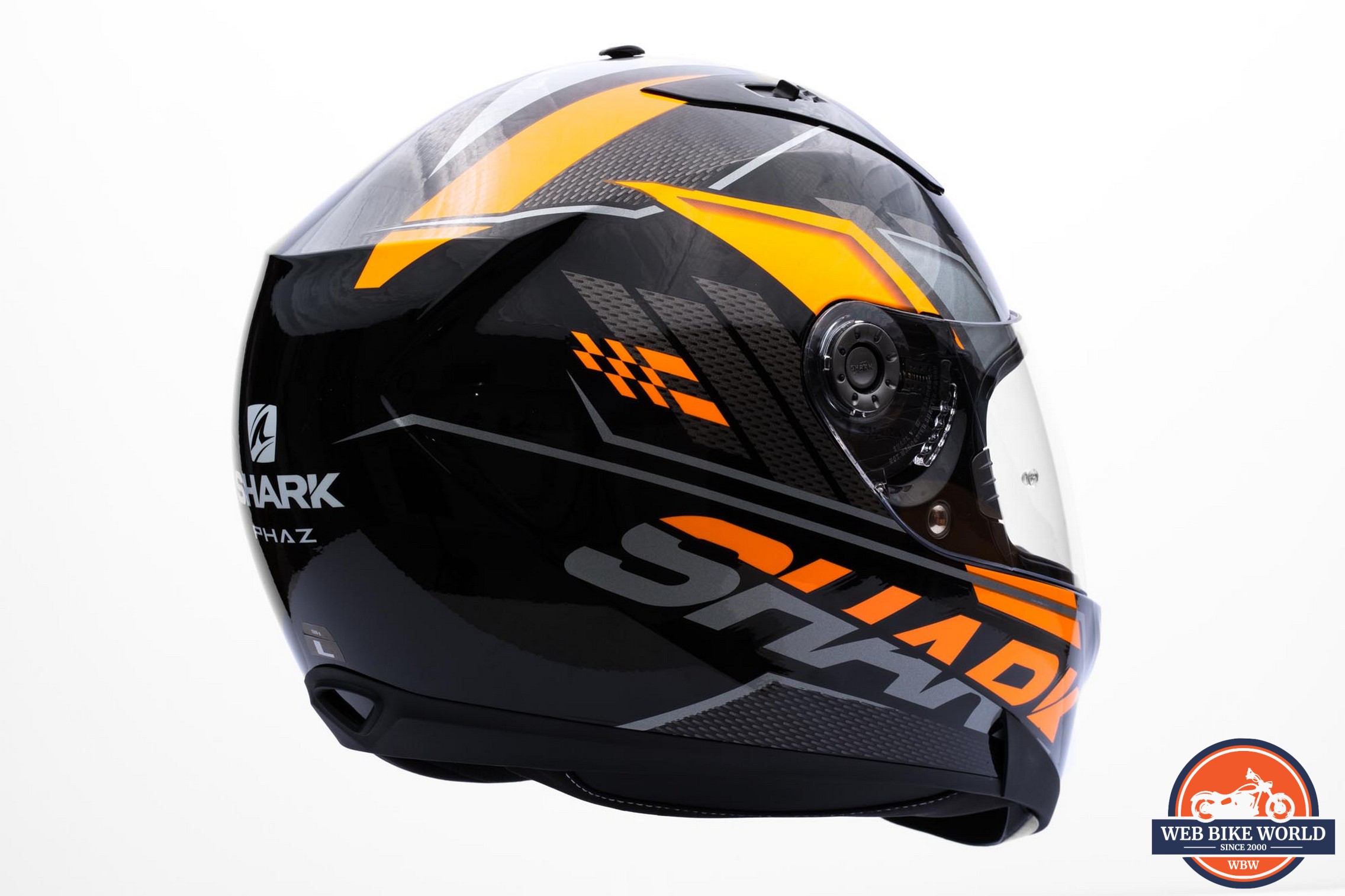

I want to point out that Shark helmets are now distributed in the United States by Troy Lee Designs, and you can find info on Shark helmets for the USA market at Troy Lee Designs. For Europe and other markets, you can head to Shark Helmets.
The Ridill is Shark’s entry level full-face helmet, but it offers some features not often found on an entry level lid. To start with, there is a drop-down internal visor, which is always nice to have in my book. Also, the main visor comes Pinlock® ready in case you are a fan of using these antifog inserts.
There’s also the strap fastener, which on the European market helmet reviewed here, comes with a micrometric buckle* instead of the basic double-D ring. In the manual for the Ridill 1.2, Shark points out that one may have either fastening solution depending on your region/market. Looking at the Ridill listed on the Troy Lee Designs site, it shows the Ridill with the Micrometric one like shown in my photos.
I should point out that there are two views on the micrometric type chin strap fastener. On the one hand, or chin, the mechanism is quick and easy to work with. One can fasten the chin strap quickly and can easily adjust it to one’s preferred snugness. Disconnecting is also super-quick with a simple tug on the release strap. However, tests have shown that a simple double-D ring is stronger than the micrometric closure. Double-D Rings are also lighter weight, as well as being easier and less expensive to implement. Now, back to our regularly scheduled program.
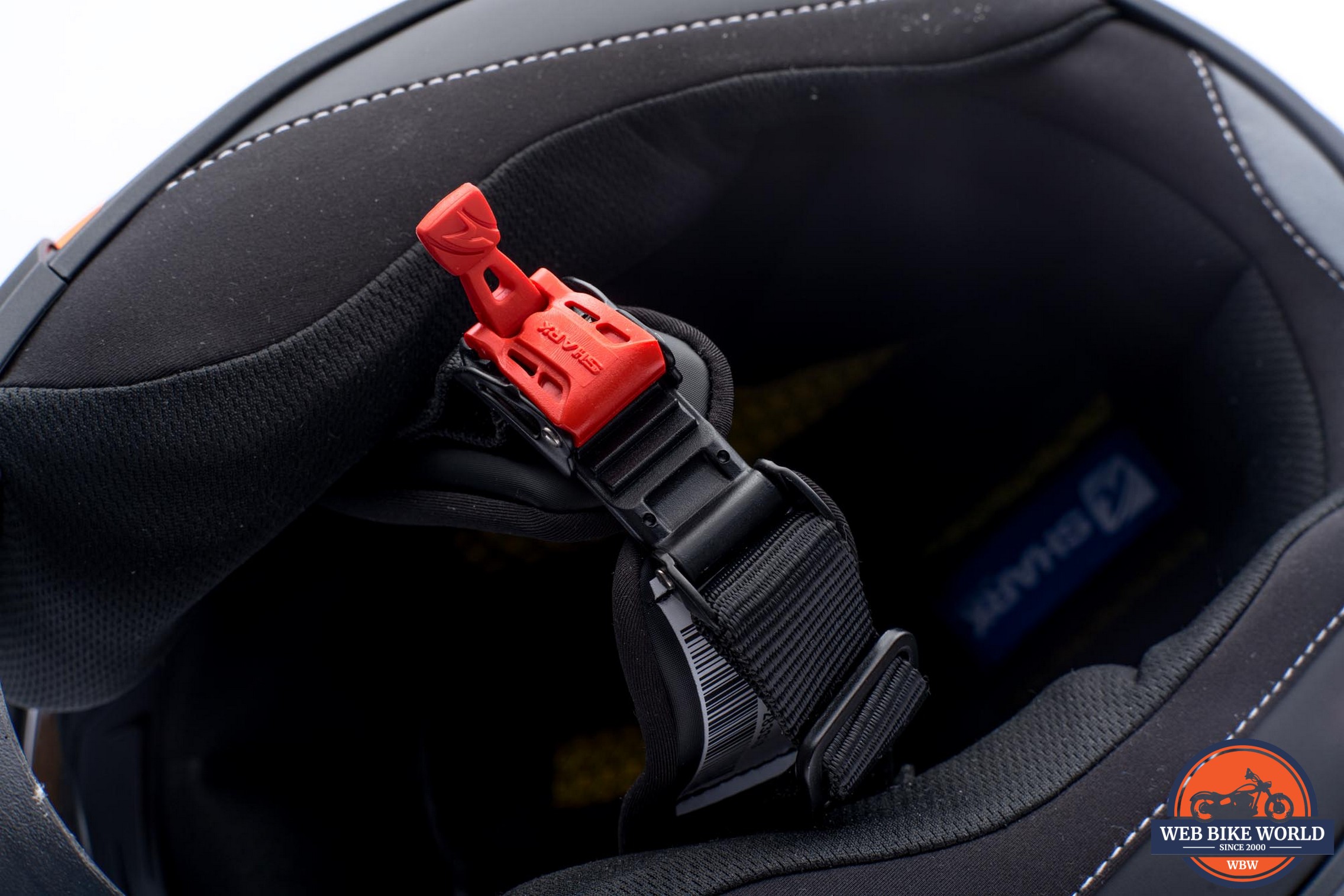

Micrometric buckle on the chin strap
The Ridill 1.2 is available in three different graphics styles that have some different color options as well as some matte options for those graphic styles. Solid colors are black, a white and black matte. The graphics/color choices my vary depending on your country/geographic location.
The overall exterior shape is closer to a touring helmet than an aggressive drop-nose full-on sport helmet and the Ridill doesn’t include a chin curtain, which is an accessory that has become quite ubiquitous in the industry over the past decade. There is a small, ~1 cm tall chin “skirt” that protrudes from the bottom of the chin guard, but it doesn’t have the same effect as a full on curtain.
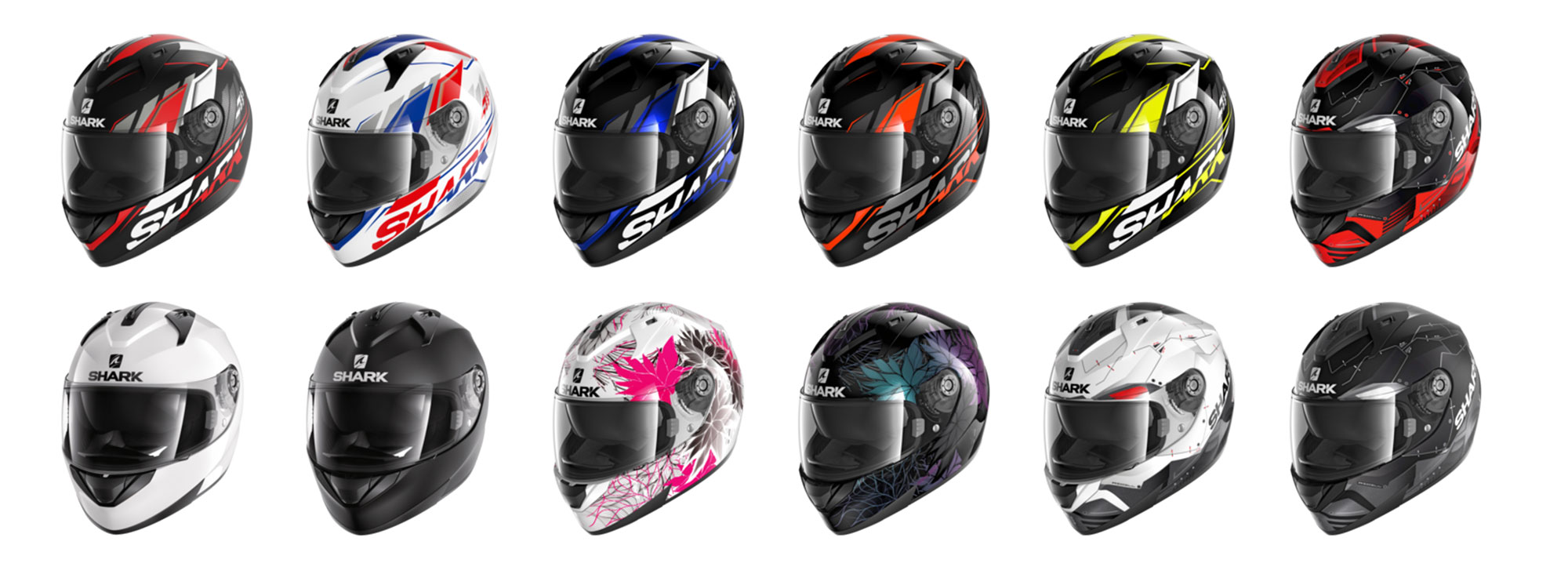

The full lineup of colors and graphics for the Ridill 1.2 from Shark’s website
Likewise, there is a short, non-removable nose/breath guard just behind the visor, but it seems to serve more as a deflector to guide air from the chin vent towards the inside of the visor rather than keep one’s exhalations off the visor interior.
Shark does include a soft, draw-string type helmet bag for storage, and there is also a set of reflective decals that can be applied to the shell for extra nighttime visibility. I thought the latter was interesting, as in the past I believe most helmet manufacturers have explicitly instructed owners not to place stickers on their helmet shells. It is a nice touch to include these and leave it up to the owner to decide if they want to add them.
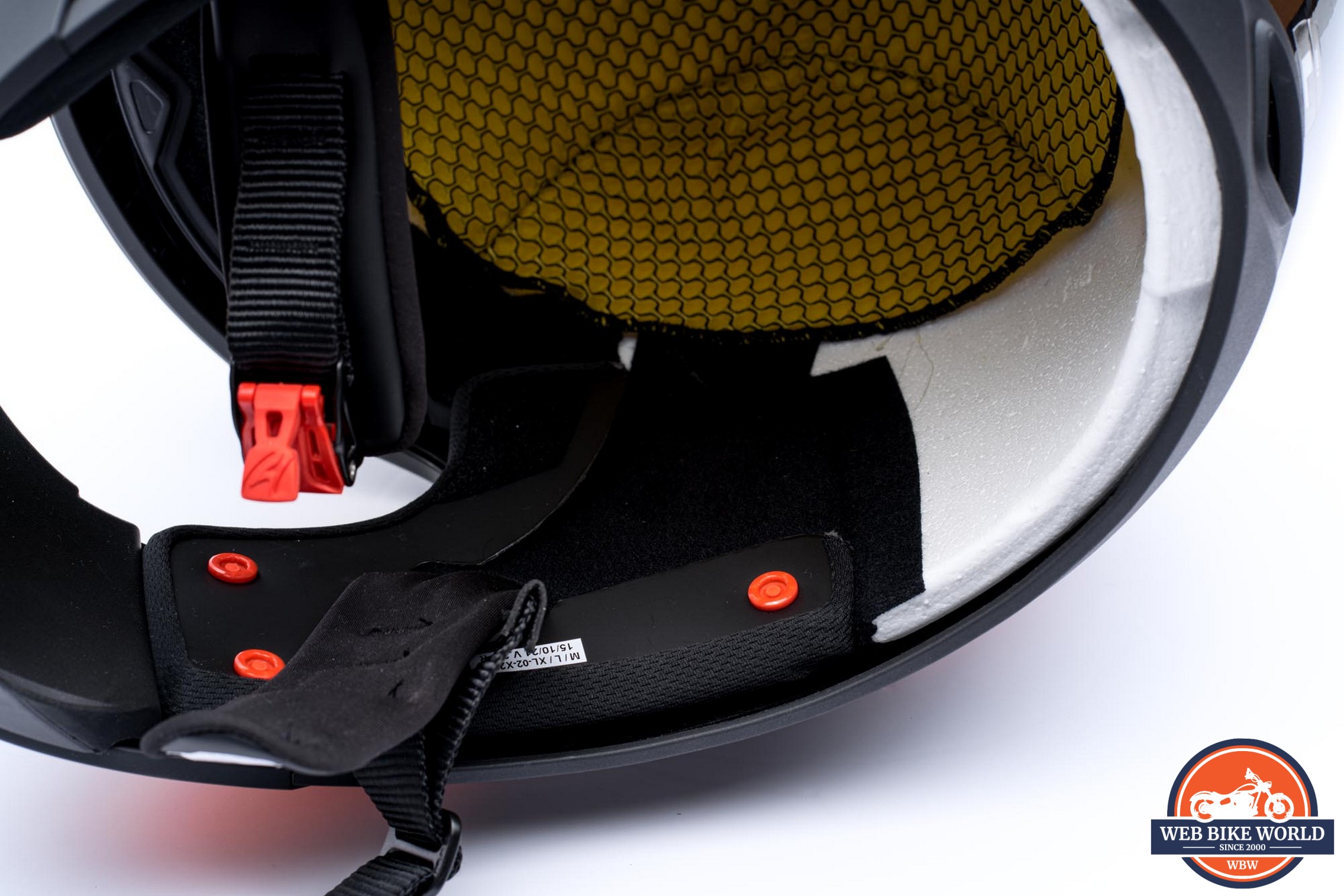

Liner and cheek pads removed, showing a patch of fabric for attaching helmet speakers
While there are no cut-outs in the EPS for helmet speakers, the EPS in the area where one would install speakers is covered with a soft fabric. This fabric mates very well with helmet speakers that include the hook portion of a hook and loop fastener on their backs. The speakers for my Sena SMH5 stuck firmly in place with their stock hook and loop fasteners.
The Shark Ridill 1.2 is a bit of a mixed bag when it comes to construction quality, with good points and some areas that make clear this helmet is built to a price. Starting with the good, we have the paint and graphics.
The graphics are well applied and seem to be aligned properly all around the helmet. The Phaz graphic is a nice looking design in my opinion, and I like the black/orange/gray color scheme that I purchased. While the helmet is overall black, the orange helps add some visibility that I appreciate. The clear coat is nice and smooth, and I didn’t find any dust or blemishes when looking closely at the exterior.
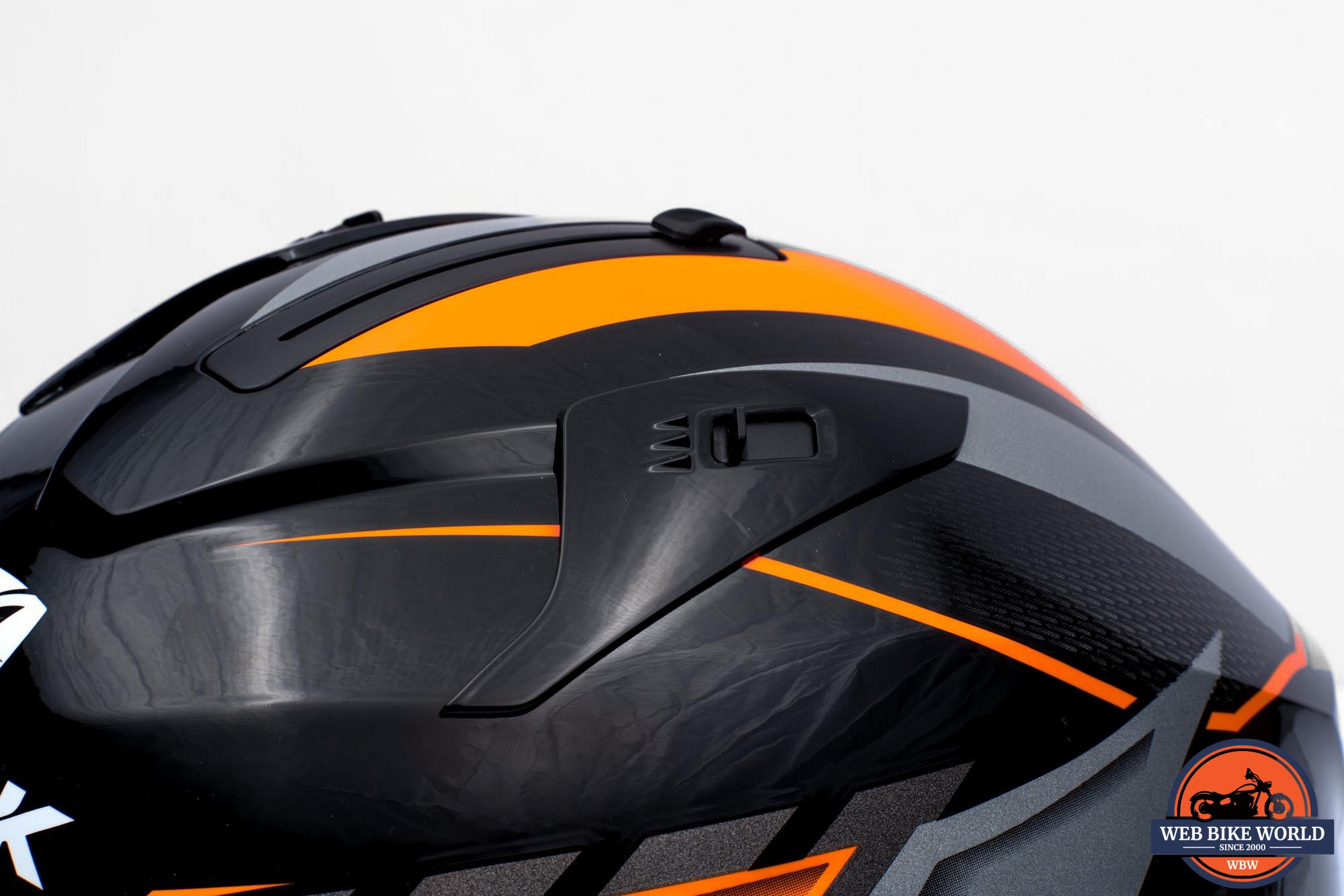

Graphics are well-placed and sharp looking. The crinkles in the photo are from my light diffuser.
The plastic surround on the lower edge of the helmet feels strong and secure and didn’t budge when I installed my Sena SMH5 headset. At the same time when I was installing that headset, I removed all the interior padding, and it came out easily and, more importantly, when back into place securely with solid click to all the snaps.
On the “suboptimal” side of things, the visor ratcheting mechanism is a bit noisy and “clacky” giving a low budget feel to opening and closing the shield. It works well enough and the visor will certainly stay in its position, but the rough ratcheting and the flex from the visor cheapens the feel.
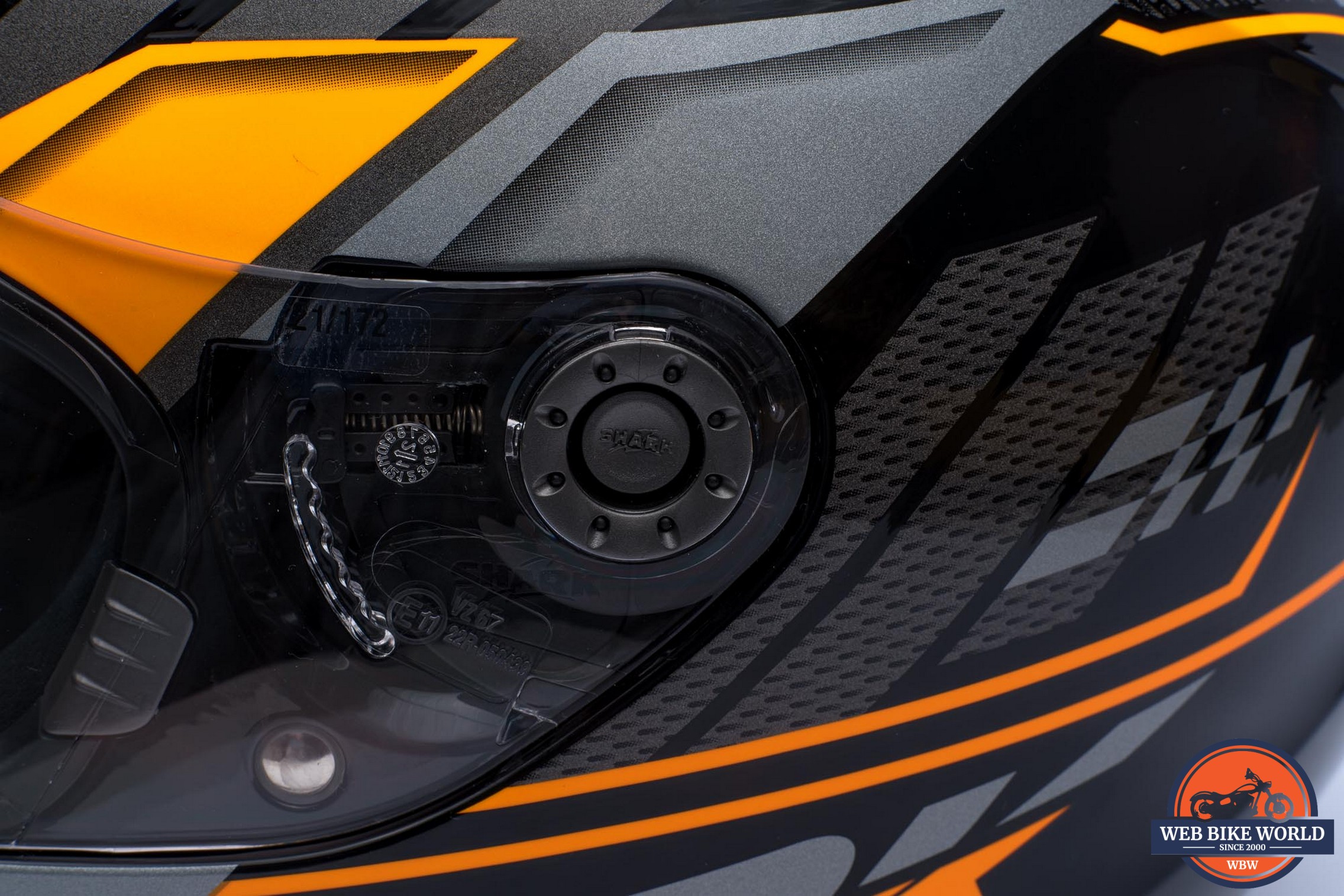

Visor mechanism and removal button
Vent switches on the top of the helmet do not have a smooth action and have a somewhat rough feel when sliding open and closed. They do, however, provide a strong tactile response, so one knows when you’ve reached the end of the switch travel, but the feel is not that of a quality item. The latter is also true of the slider for the drop-down visor. The feel of the slider is a bit loose and not smooth, and has much less tactility than the vent switches.
Another thing that says to me “budget helmet” is the visor pivot mechanisms. On almost every helmet I’ve owned in the past, the visor pivots were screwed into the helmet. This, along with short paths cut into the mounting holes, provided a way for one to adjust how tight, or loose, the visor seals up against the viewport. With the Ridill, the visor pivots simply snap into the shell of the helmet with plastic tabs.
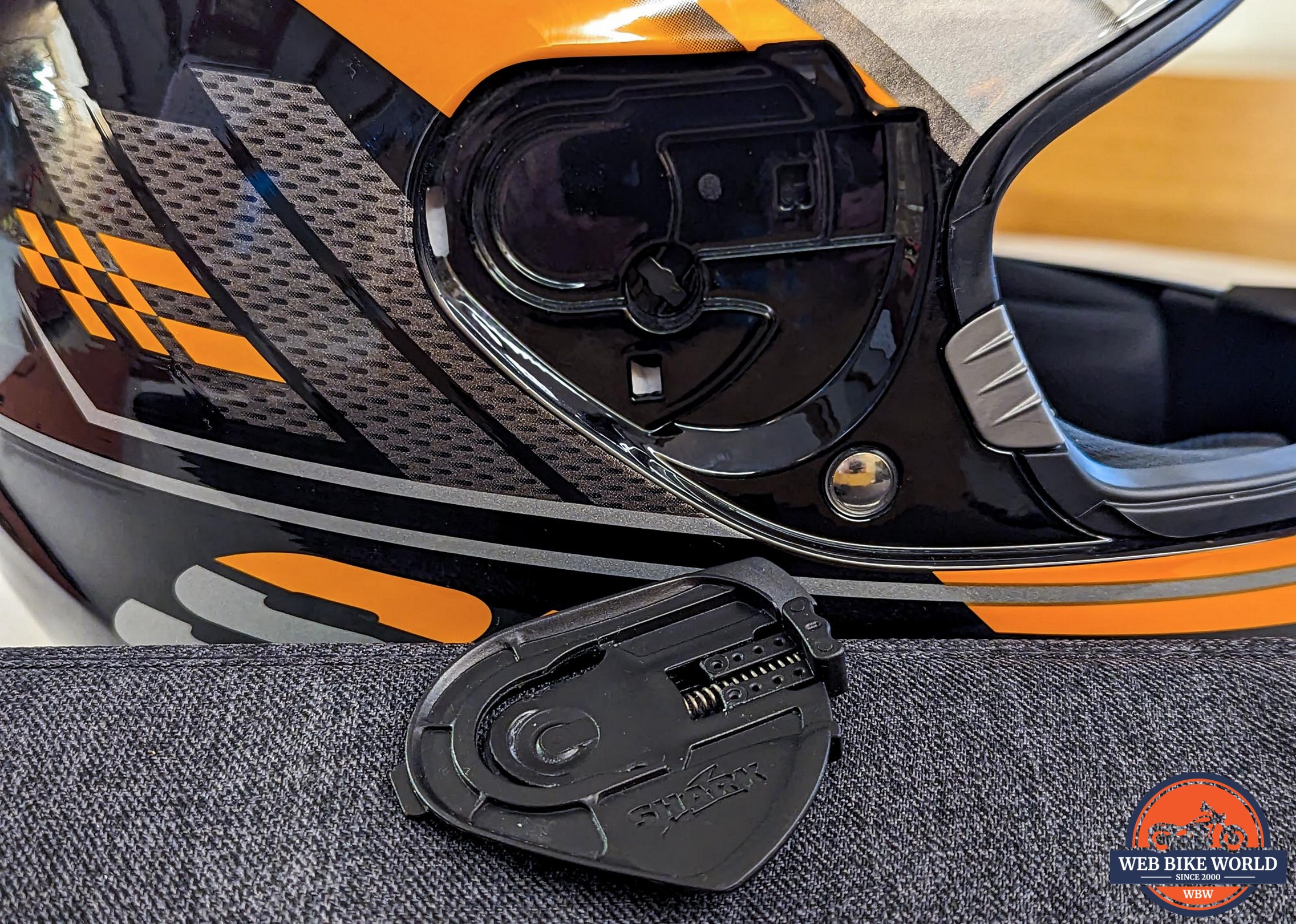

Visor pivot mechanism installed via snap-in versus screws so no seal adjustment here
I might not have noticed this except for the fact I noticed the visor just barely meets the gasket of the viewport. When I went looking to adjust this, I found there were no screws, so this was a no-go. Worse, the right side visor pivot is slight loose in its mount. The left side was snug in position, but I think someone dropped the ball on this design aspect.
So overall, I’m only giving the Ridill 1.2 only 3.5 stars for Build Quality. Hopefully the pivot mechanism looseness is isolated to my specific unit and isn’t an issue across the series.
According to Shark’s sizing chart, the Ridill size large should fit 59-60 cm head sizes, and for me this was spot on. I’m not surprised as Shark helmets have always fit me well in a size large and the Ridill continues this tradition. It was snug at first, as it should be, but even after five hours of riding on the first day I got it, it never became uncomfortable.
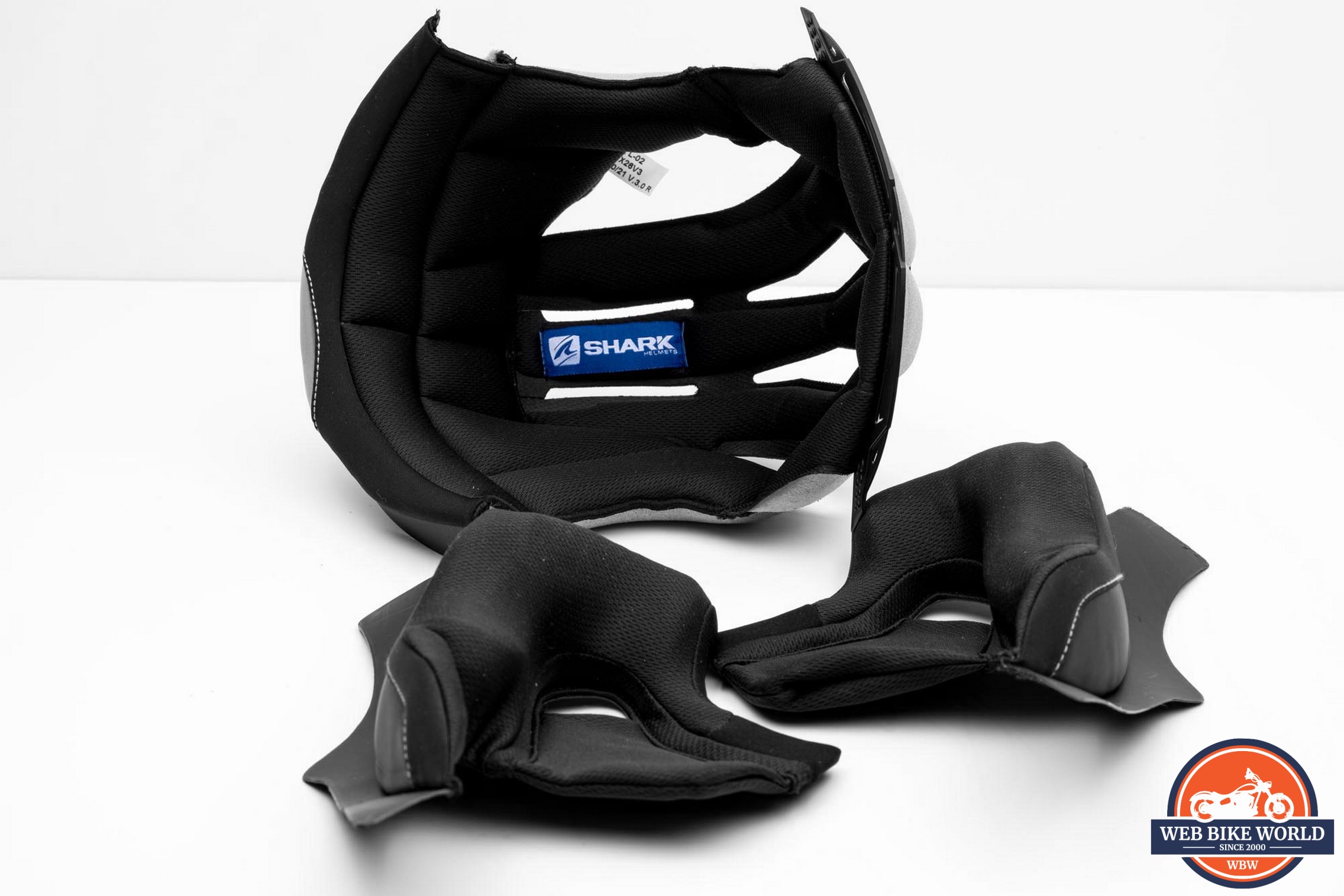

Interior cheek pads and liner are easy to remove and install and are washable
The only thing I noticed was a bit of pressure against my jawbone where the chinstrap was against it. Not enough to be an issue, but maybe a bit less padding in the cheek pads in that area might clear that up.
The interior lining of the cheek pads and upper padding is smooth and soft, but it isn’t the smoothest or softest. While comfortable enough, and I had no complaints, I’ve worn helmets that felt a little better. I should also mention there is plenty of chin/jaw room in the Ridill 1.2. I tried my best to touch the interior chin bar with my chin and couldn’t do it, and that’s less common for me than not.
I’ll give the Ridill 1.2 four stars for sizing and comfort.
The main visor on the Ridill 1.2 is 2.2mm thick, so it is prone to flex. This is good in one aspect, in that the flexibility can be a good thing under certain impact types. On the other hand, it also wants to twist when raising the visor since the lift tab is off to the left-hand side. This can be mitigated by placing the lift tab in the center, like on Shark’s own Spartan helmet. While overall this doesn’t really harm performance, the twist makes the visor lifting a bit awkward and can make it less easy to open.
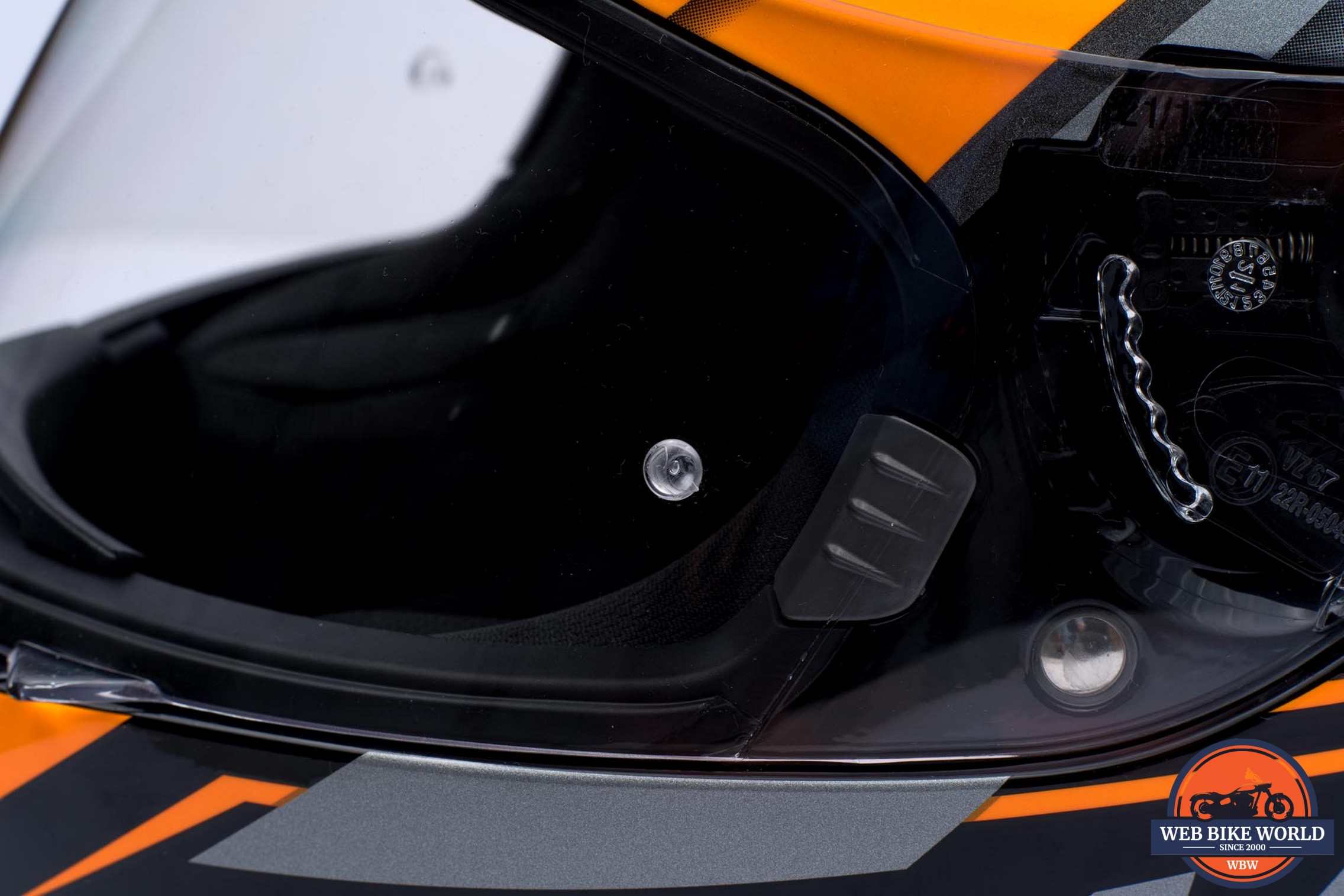

On the plus side, the main visor offers a very clear view with little distortion, which has been typical of the Shark helmets I’ve reviewed in the past. The internal sunshade visor does have some visible distortion and is about average in this aspect. I should also mention that while no Pinlock® insert is included with the Ridill 1.2, the main visor is pinned for installing one if desired.
While on the topic of the sunshade, I would like to see a darker tint present here. This is a common issue to many of these internal visors across brands, so it’s not specific to Shark. Still, it could do with a darker tint, in my opinion.
Also, I’m not a fan of the slider on top of the helmet used to deploy the sunshade. It is quite a reach to the top of the helmet and the sliding action isn’t that smooth and has an overall “inexpensive” feel. It is nice that it can be placed anywhere within its range of motion and will stay in place there. The internal visor also comes down pretty far, leaving only a small gap between the chin bar when fully lowered. This of course will depend on the shape of one’s head, so your view may vary.
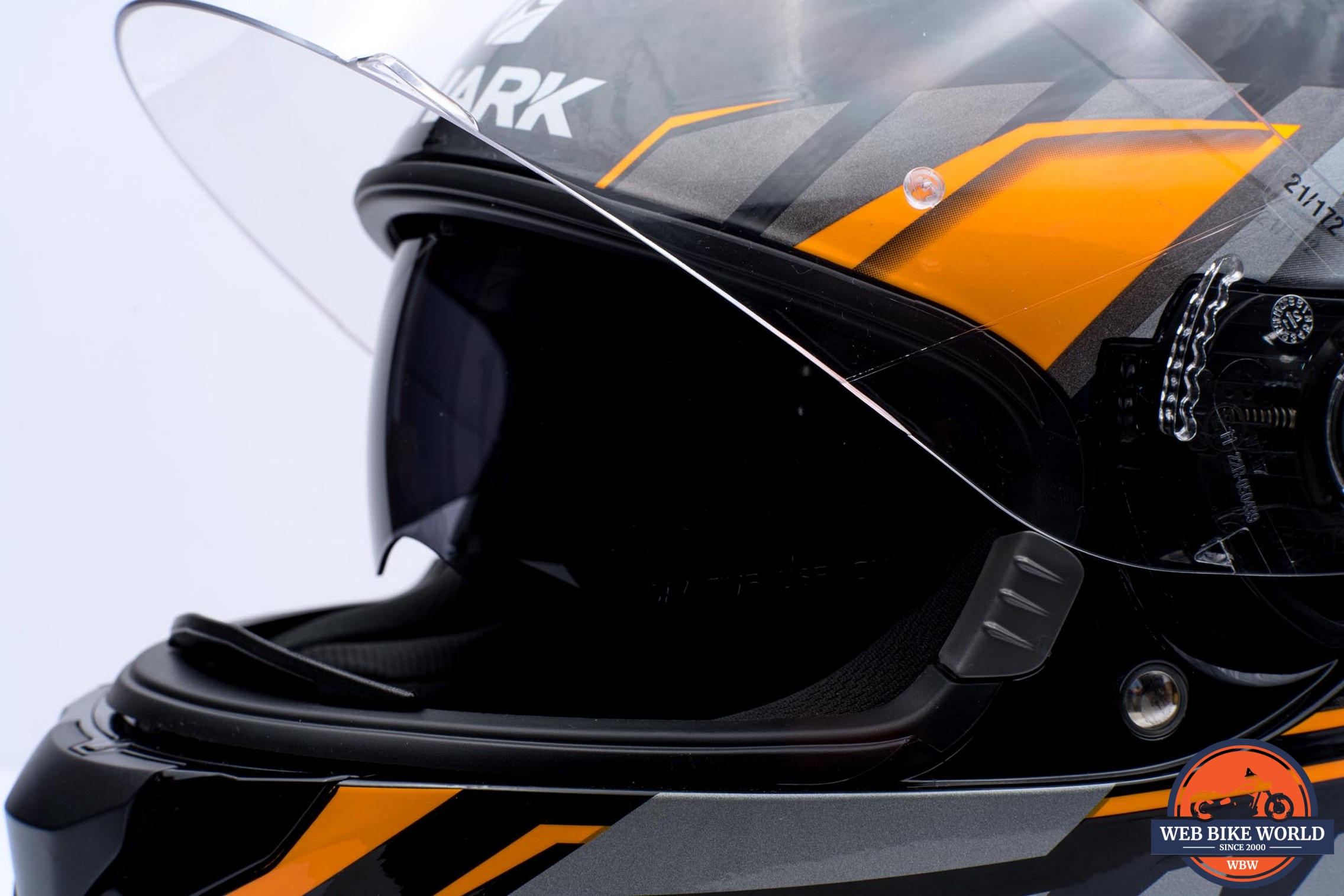

The eyeport offers very good peripheral views, with the top to bottom space being good without being great. I found it was fine for viewing clocks towards the bottom but leaning forward, the top of the eyeport does intrude into one’s view a bit. Those who ride in fully tucked positions often might find the top view a bit restrictive.
Removal of the main visor is very easy using a mechanism that Shark has been using for a long time. Opening the visor to any height and then pressing the button in the center of the visor pivot allows the visor to slide forward and out of the pivot mechanism. This is the same as the Shark S900 we reviewed thirteen years ago. In fact, the visors look to be interchangeable between these helmets.
[IMG alt="Front view of the Shark Ridill 1.2 helmet
"]https://www.webbikeworld.com/wp-content/uploads/2023/05/Shark-Ridill-Helmet-Review-8.jpg[/IMG][IMG alt="Front view of the Shark Ridill 1.2 helmet
"]https://www.webbikeworld.com/wp-content/uploads/2023/05/Shark-Ridill-Helmet-Review-8.jpg[/IMG]
Installing simply requires one to slide the pivot points back in the mechanism, where they lock in with a solid click. For the internal visor, one simply lowers the visor and gives it a solid tug to remove. Reinstallation is a bit tricky to get it lined up, but once it is lined up it can be pressed back into place.
I’ll give the Ridill 1.2 a full four stars for visors and visibility losing one star due to the thin material and associated flex along with the quality of the visor ratcheting mechanism.
Average is the best way I feel I can describe the ventilation on the Ridill 1.2. Up front, we have a chin bar vent which operates in a “rocker switch” style. Pressing on the lower edge of the vent opens it, while pressing pretty much anywhere else on the front of it closes it. However, with the switch in either position, I didn’t feel much difference in airflow.
The vent appears to be designed to rely on air coming up and over the front of the vent cover and then down into the chinbar where it is then exhausted behind the small, flexible panel just behind the visor. This up and down airflow path seems less than optimal, and as best as I can tell, would only spill some air onto the back of the visor for defogging.
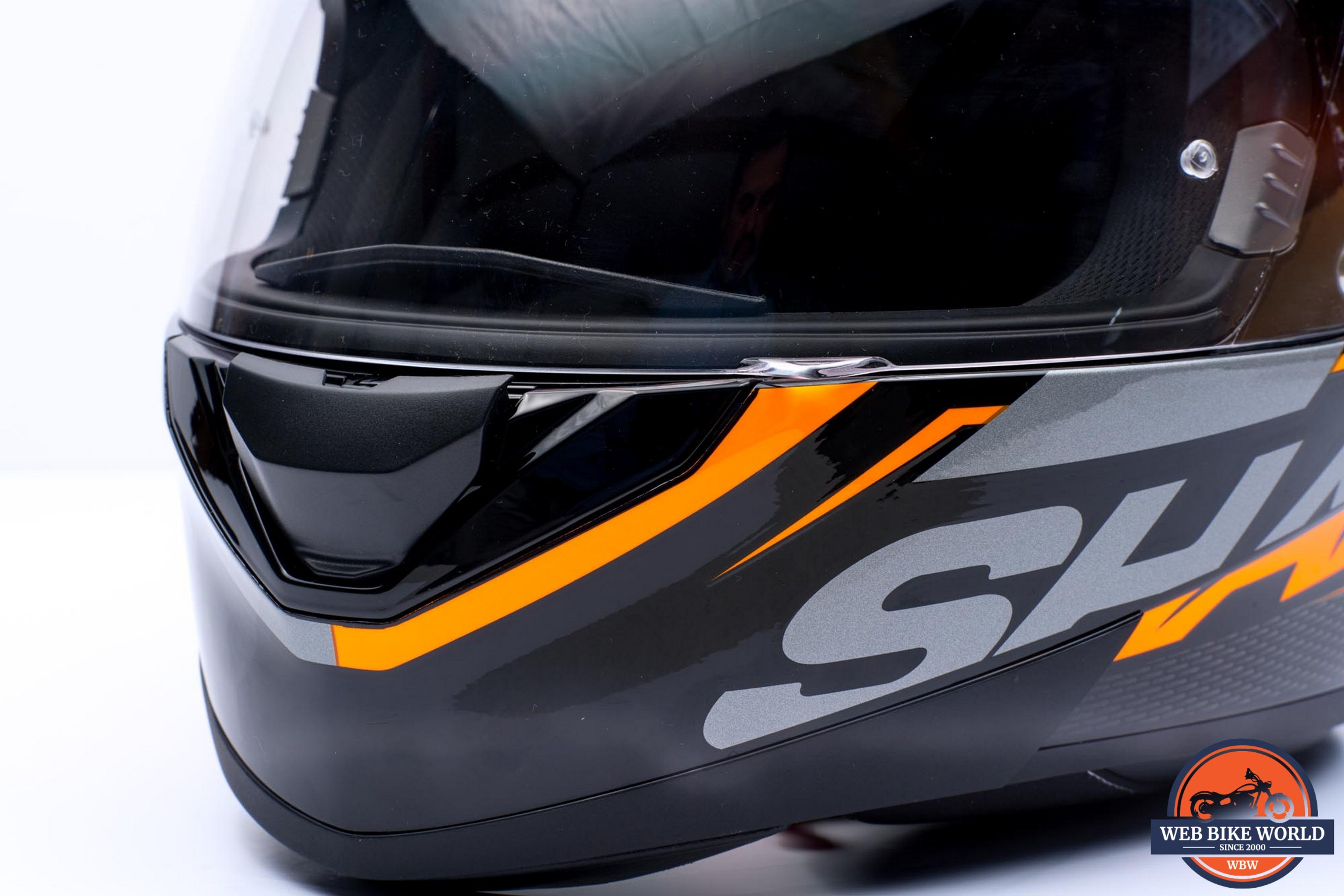

Since the small air deflector can’t be removed, the airflow path can’t really be changed. Also, the chinbar lacks any direct vents that can sometimes be found in the back of the chinbar on other helmets that can direct air right onto the face.
Two top vents are present on top of the helmet, with two switches flanking the central slider for the drop-down visor. They are a bit stiff to move, but they do offer a very tactile “click” when opened and closed. Unfortunately, I felt little to no airflow on the top of my head when opening them. Even at highway speeds, I found it difficult to tell if I had opened them or not. Behind the windscreen or standing up on the pegs didn’t make things any better or worse.
I’m going to venture a guess that the lack of exhaust venting at the rear of the helmet could be hampering the venting. There are no rear vents that I can find on the Ridill 1.2 and without the negative pressure of a rear vent to pull interior air out, airflow is going to be compromised.
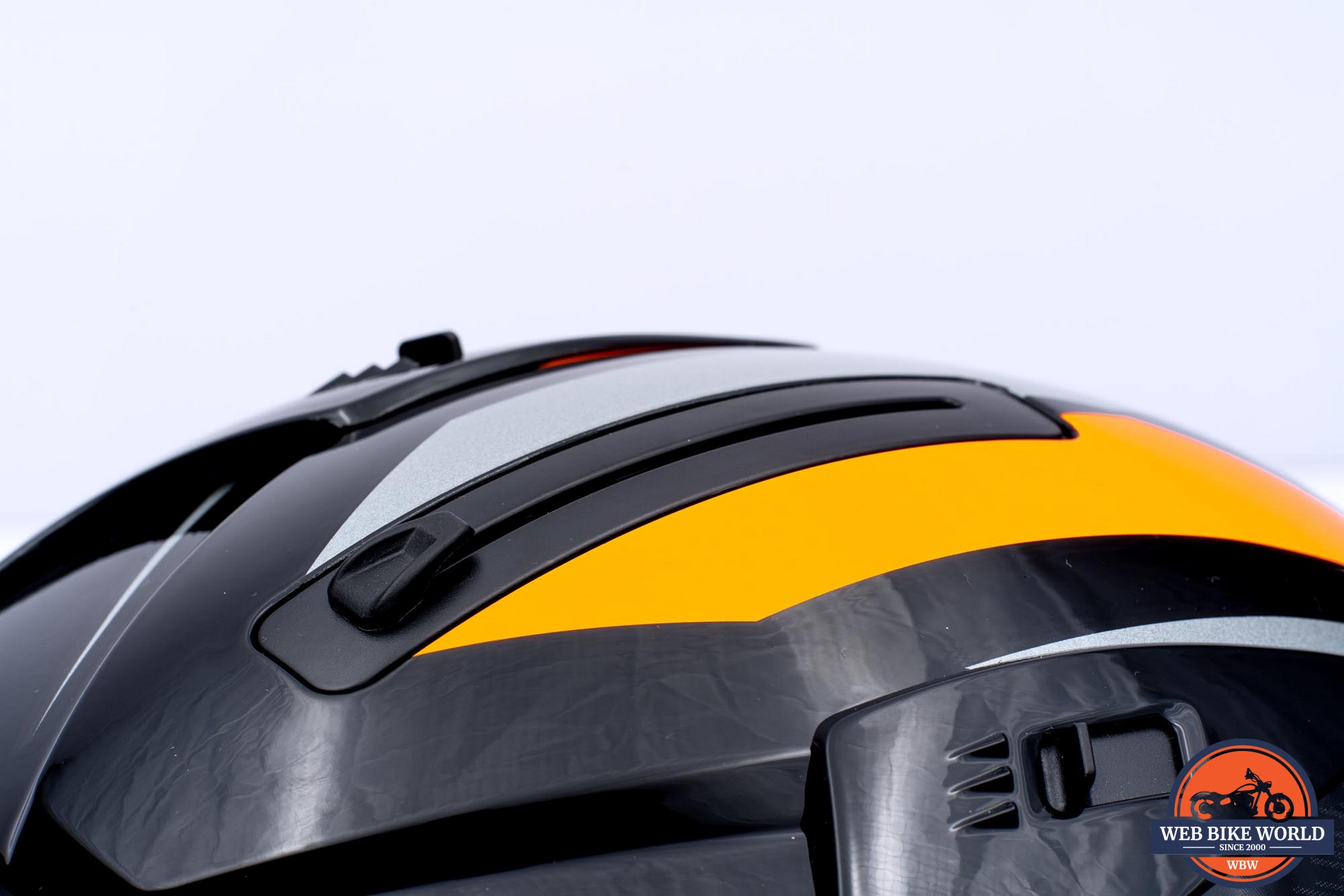

One last thing to note is that since there is no chin curtain, the helmet lets a lot of air flow up under the chin bar. This does provide a lot of airflow, but it also can be a bit much and in my case the air would dry out my eyes at highway speeds. This also made it difficult to tell if the chin vent was actually doing any work. With this in mind, one does get airflow but provide very little control of said airflow.
With the above in mind, I’m giving the Ridill 1.2 only 3.0 stars for ventilation.
I took the Ridill 1.2 out for evaluation rides on a KTM 390 adventure and on a Voge AC350 naked bike, the former with the stock windscreen. On the 390, with its short windscreen and upright position, the disrupted air coming off the top of the screen was coming right for my face. As such, the noise above 40 mph was significant, as was some buffeting.
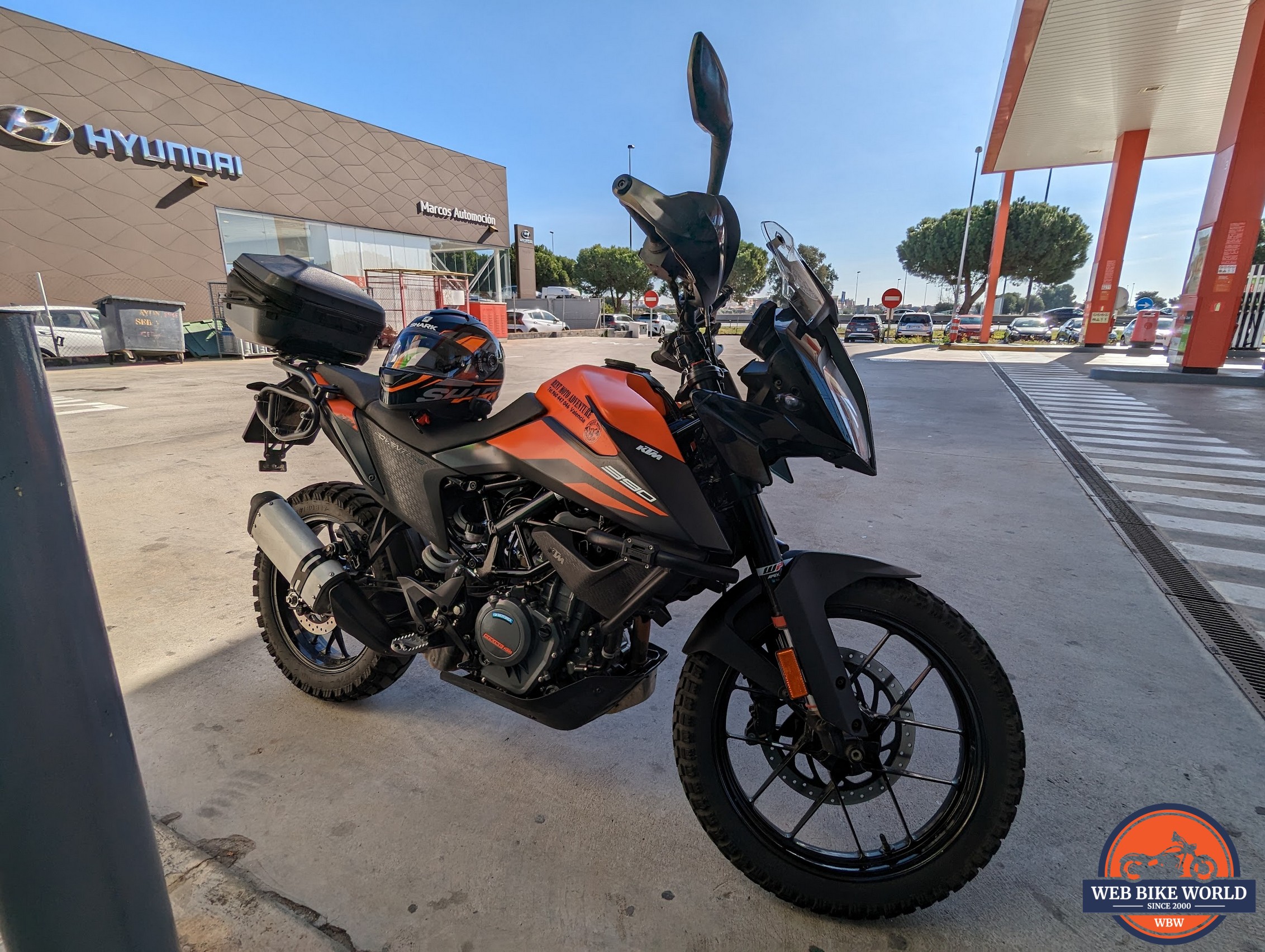

Test bike for my initial ride with the Shark Ridill 1.2, a KTM 390 Adventure
Standing up on the pegs and getting the helmet into “clean” air did improve things but there was still what I would consider “average” control of noise with this helmet at highway speeds. This was mostly wind rushing noise but there is also some “booming” low frequencies making to my ears.
The same was the case similar to riding on the AC350. As it had no windscreen it was certainly a quieter ride here than on the KTM. Also, there was less booming than on the KTM, even when standing on the KTM pegs, but it was still there.
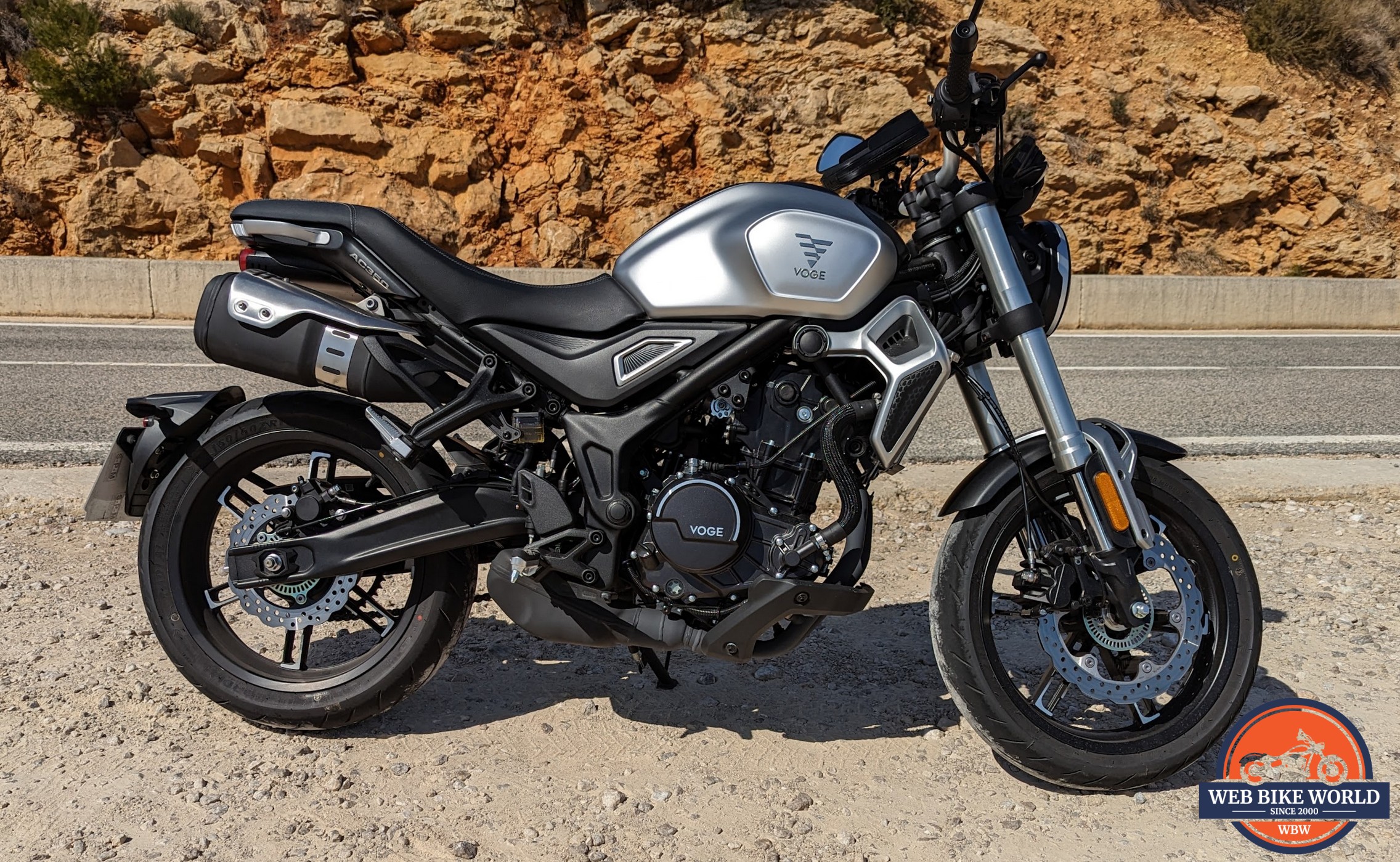

Second steed for evaluating the Shark Ridill helmet, a Voge AC350
The noise levels in clean air aren’t bad or good and if one wears earplugs, like I do, then it’s not a bother. I feel if one is riding a naked bike, noise shouldn’t be a problem and I really had little complaint riding on the AC350 for most of a day with this helmet on. It might also do well behind taller touring screens, but I don’t have access to a bike to check. Of course, this is also dependent on rider height so your “mileage may vary”.
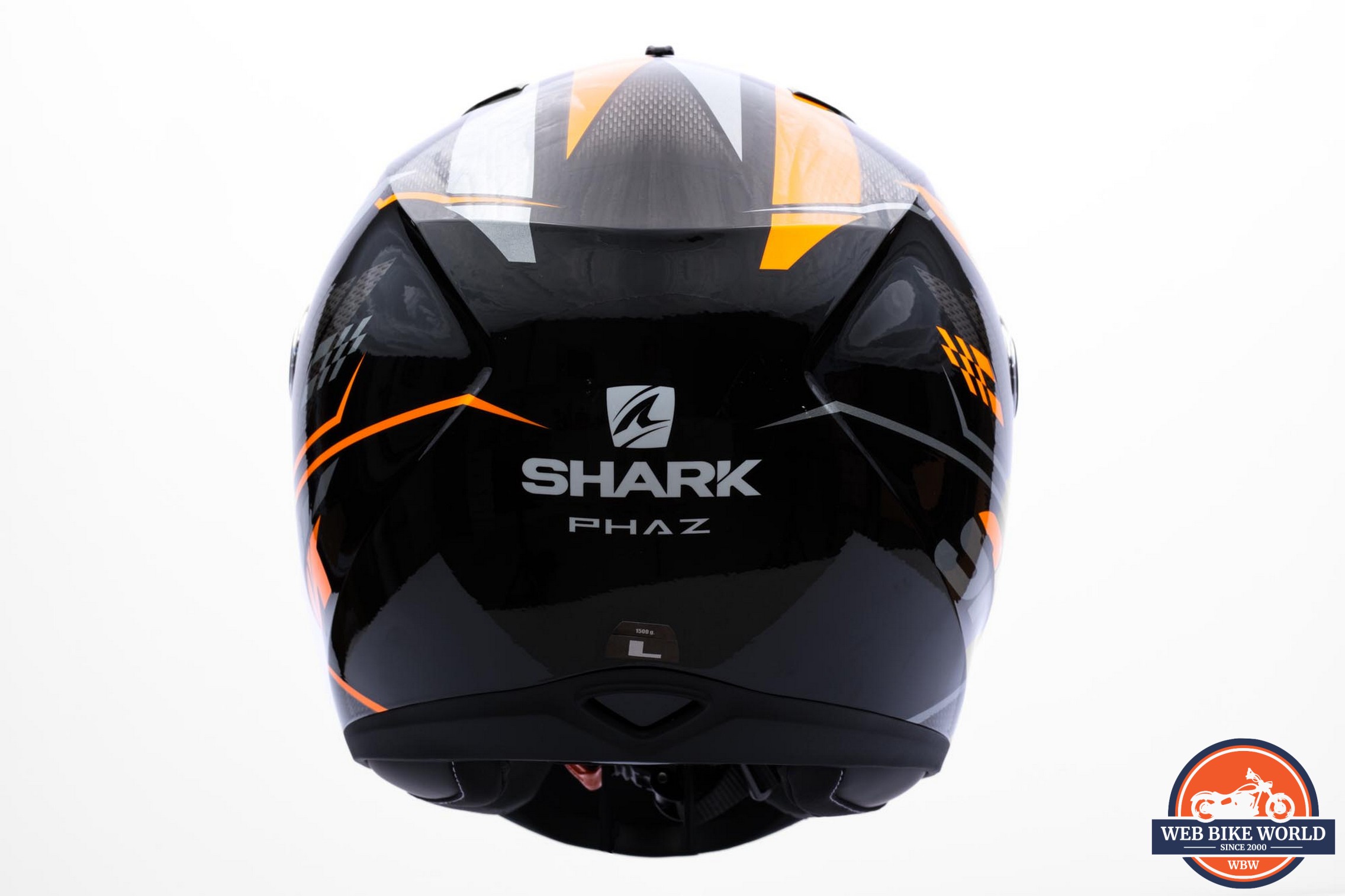

The one decal that isn’t applied straight is the “L” but it is easy to remove

The Ridill 1.2 gets a three-star rating from me for noise levels based on my experience with this helmet compared to the various ones I’ve owned and reviewed in the past.
Under the UK’s Sharp Helmet Rating scheme, the Ridill scores four out of five stars for impact protection. It performed very good where impacts were applied to the front, top, and back areas and did “good” in impacts at the left and right sides. They don’t call out if there is update for the Ridill 1.2 or if they even distinguish between the two, but I don’t believe the shells and EPS are different between these variants.
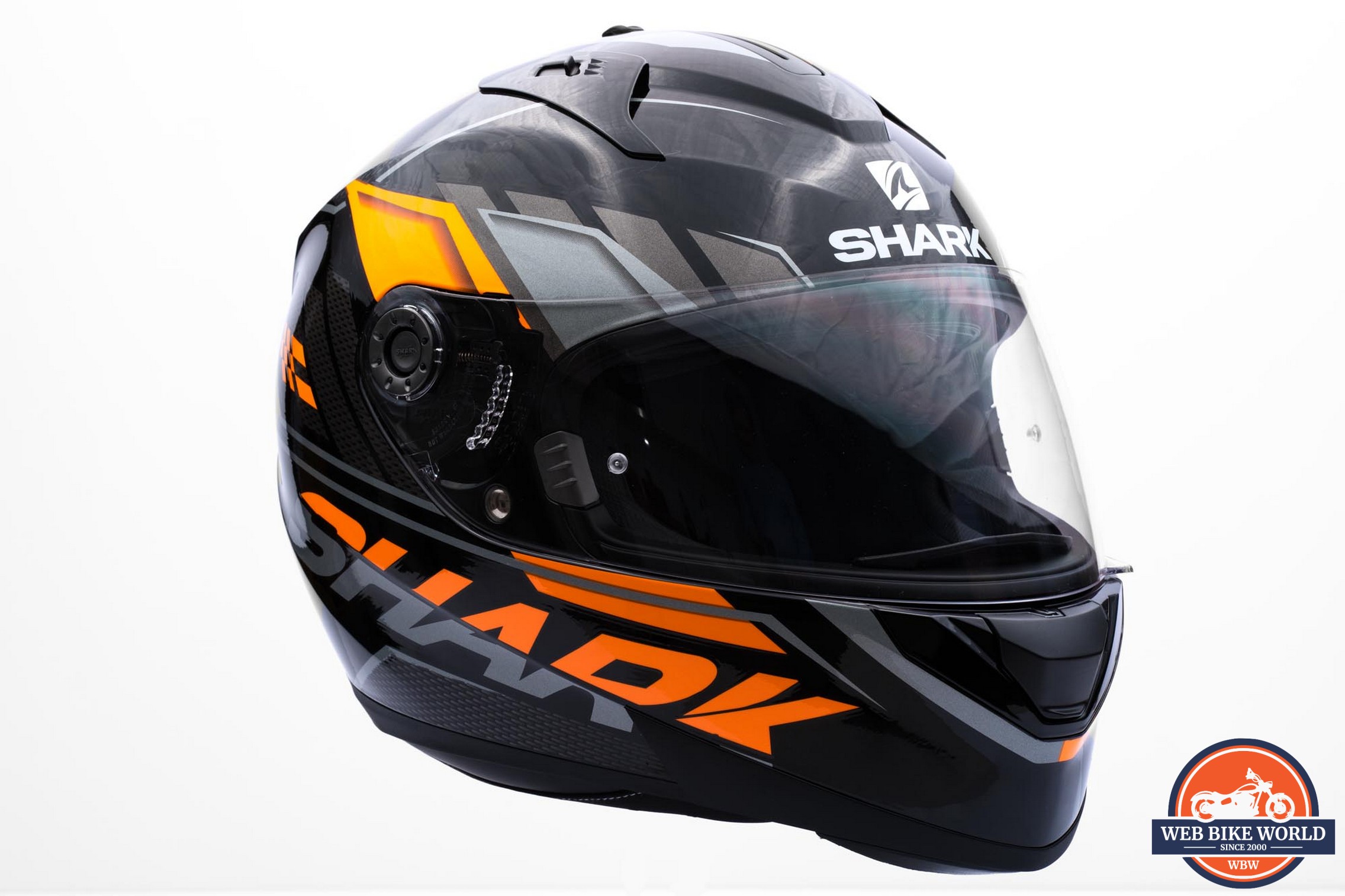

The helmet meets ECE R 22/05 for Europe and DOT for the United States. It lacks Snell certification, but this is common among helmets that have an internal sunshade. As mentioned earlier, Shark includes a set of reflective decals that can be applied to the shell for additional nighttime visibility.
As such, I’m giving the Ridill 1.2 four stars for providing good impact performance and the inclusion of the reflective decals.
While not an ultra-light helmet, the Ridill 1.2 is listed as being 1550 g (3lbs 6.7oz). The size L sticker on the back of the actual helmet lists the weight as 1500 g (3lbs 4.9oz). To be sure I provided the correct number, I weighed it myself and came up with, 1547 g (3lbs 6.6oz).
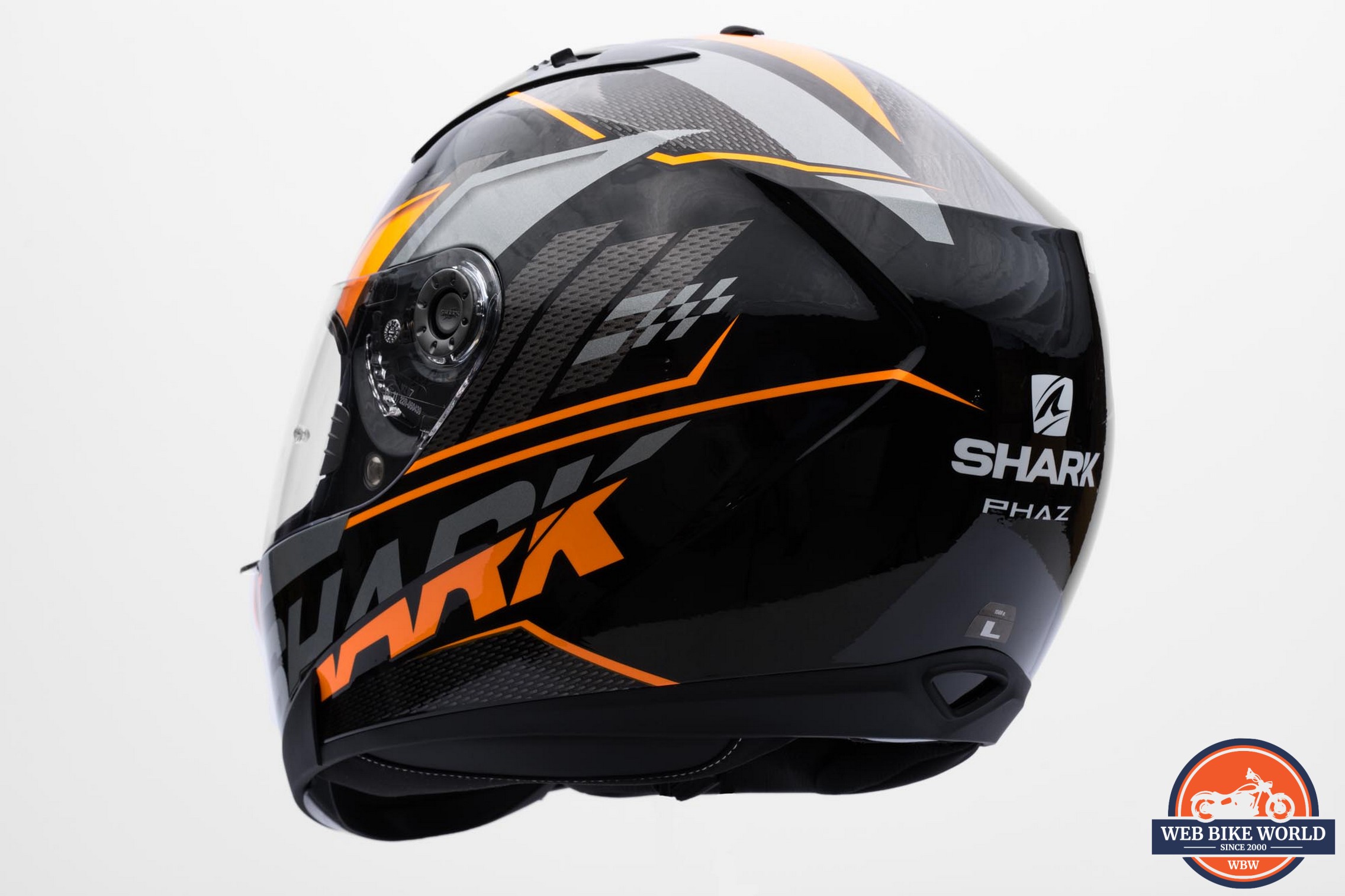

This puts it at number 51 (out of 272) in weight of helmets according to our list here at Web Bike World. This puts it in good company, especially for a polycarbonate shell helmet with a sunshade. Picking up the helmet, it does have a solid feel without feeling heavy, and I never felt like it was anything but well-balanced during my riding with it.
I’ll give the Ridill 1.2 a four-star rating for helmet weight.
I feel the Ridill is a reasonable helmet at a reasonable price. The overall build quality is good, but is marred by some small issues like the visor pivots and the less than stellar vent controls. The appearance is certainly good as far as paint and graphics go, and the shell is strong and solid. This is reflected in the SHARP safety score so as a piece of protective gear, it does the job.
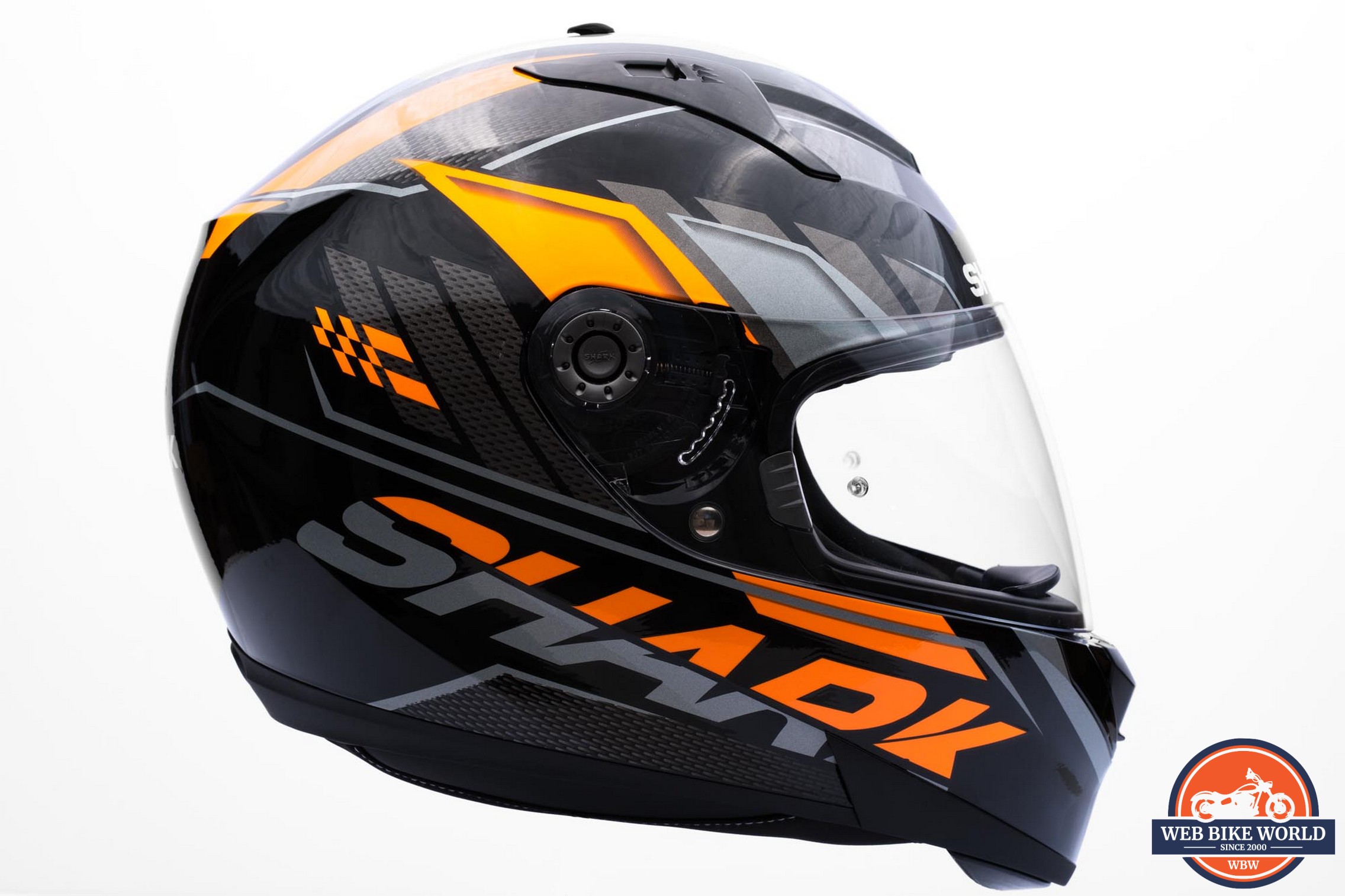

If one rides a naked bike or similar bike with little to no windscreen, noise levels are OK and if one wears earplugs it is a nice space to keep your head for a few hours of riding. Bikes with windscreens of a certain height, in combination with riders of a certain height, might find the noise very high and might also suffer from a shaky, buffeted experience on the road.
In the end, I’d like to give the Ridill fours stars because of the good things it brings to the party, but I feel that’s letting it off a bit easy, so I’ll settle for three and half.
Buy Now
RevZilla Troy Lee Designs
The post Shark Ridill 1.2 Full Face Helmet Review appeared first on webBikeWorld.
Continue reading...
Review Summary
Shark’s entry level full-face helmet brings a lot to the party for its sub $200 (USD) price with very good build quality, a drop-down visor, and clear visibility through said visor. However, just average noise levels and “fair” ventilation leave it up against stiff competition such as the Scorpion EXO-420 which is a bit lower in price.
Build Quality
Sizing & Comfort
Visibility
Ventilation
Noise
Safety
Weight
Pros
Good quality build (mostly)
Low distortion main visor
Pinlock®-ready visor
Micro-metric strap fastener*
Cons
Drop-down visor mechanism placement
No chin curtain
Below average ventilation
Micro-metric strap fastener
3.6
Average, With Drawbacks
Shark Ridill 1.2 Full Face Helmet Image Gallery














































Buy Now
RevZillaTroy Lee Designs
Introduction
For those of you who are long-time readers of WebBikeWorld, you may have noticed I have been absent for a while. Over the past year I have retired, sold our home in Tennessee, and moved to Valencia, Spain. For most of 2022 I didn’t even have a motorcycle to ride, so that precluded reviewing things motorcycle related.
Now that I’ve gotten settled here, I have started taking the steps to getting back to riding and since I sold almost all of my gear, I of course needed to make some purchases which included a helmet. I wanted to purchase a new lid from a “known quantity” and not spend too much money at this point, so when I arrived at the nearby moto shop, I naturally gravitated to one of my favorite helmet brands, Shark.


I want to point out that Shark helmets are now distributed in the United States by Troy Lee Designs, and you can find info on Shark helmets for the USA market at Troy Lee Designs. For Europe and other markets, you can head to Shark Helmets.
The Shark Ridill 1.2
The Ridill is Shark’s entry level full-face helmet, but it offers some features not often found on an entry level lid. To start with, there is a drop-down internal visor, which is always nice to have in my book. Also, the main visor comes Pinlock® ready in case you are a fan of using these antifog inserts.
There’s also the strap fastener, which on the European market helmet reviewed here, comes with a micrometric buckle* instead of the basic double-D ring. In the manual for the Ridill 1.2, Shark points out that one may have either fastening solution depending on your region/market. Looking at the Ridill listed on the Troy Lee Designs site, it shows the Ridill with the Micrometric one like shown in my photos.
I should point out that there are two views on the micrometric type chin strap fastener. On the one hand, or chin, the mechanism is quick and easy to work with. One can fasten the chin strap quickly and can easily adjust it to one’s preferred snugness. Disconnecting is also super-quick with a simple tug on the release strap. However, tests have shown that a simple double-D ring is stronger than the micrometric closure. Double-D Rings are also lighter weight, as well as being easier and less expensive to implement. Now, back to our regularly scheduled program.


Micrometric buckle on the chin strap
The Ridill 1.2 is available in three different graphics styles that have some different color options as well as some matte options for those graphic styles. Solid colors are black, a white and black matte. The graphics/color choices my vary depending on your country/geographic location.
The overall exterior shape is closer to a touring helmet than an aggressive drop-nose full-on sport helmet and the Ridill doesn’t include a chin curtain, which is an accessory that has become quite ubiquitous in the industry over the past decade. There is a small, ~1 cm tall chin “skirt” that protrudes from the bottom of the chin guard, but it doesn’t have the same effect as a full on curtain.


The full lineup of colors and graphics for the Ridill 1.2 from Shark’s website
Likewise, there is a short, non-removable nose/breath guard just behind the visor, but it seems to serve more as a deflector to guide air from the chin vent towards the inside of the visor rather than keep one’s exhalations off the visor interior.
Shark does include a soft, draw-string type helmet bag for storage, and there is also a set of reflective decals that can be applied to the shell for extra nighttime visibility. I thought the latter was interesting, as in the past I believe most helmet manufacturers have explicitly instructed owners not to place stickers on their helmet shells. It is a nice touch to include these and leave it up to the owner to decide if they want to add them.


Liner and cheek pads removed, showing a patch of fabric for attaching helmet speakers
While there are no cut-outs in the EPS for helmet speakers, the EPS in the area where one would install speakers is covered with a soft fabric. This fabric mates very well with helmet speakers that include the hook portion of a hook and loop fastener on their backs. The speakers for my Sena SMH5 stuck firmly in place with their stock hook and loop fasteners.
Build Quality
The Shark Ridill 1.2 is a bit of a mixed bag when it comes to construction quality, with good points and some areas that make clear this helmet is built to a price. Starting with the good, we have the paint and graphics.
The graphics are well applied and seem to be aligned properly all around the helmet. The Phaz graphic is a nice looking design in my opinion, and I like the black/orange/gray color scheme that I purchased. While the helmet is overall black, the orange helps add some visibility that I appreciate. The clear coat is nice and smooth, and I didn’t find any dust or blemishes when looking closely at the exterior.


Graphics are well-placed and sharp looking. The crinkles in the photo are from my light diffuser.
The plastic surround on the lower edge of the helmet feels strong and secure and didn’t budge when I installed my Sena SMH5 headset. At the same time when I was installing that headset, I removed all the interior padding, and it came out easily and, more importantly, when back into place securely with solid click to all the snaps.
On the “suboptimal” side of things, the visor ratcheting mechanism is a bit noisy and “clacky” giving a low budget feel to opening and closing the shield. It works well enough and the visor will certainly stay in its position, but the rough ratcheting and the flex from the visor cheapens the feel.


Visor mechanism and removal button
Vent switches on the top of the helmet do not have a smooth action and have a somewhat rough feel when sliding open and closed. They do, however, provide a strong tactile response, so one knows when you’ve reached the end of the switch travel, but the feel is not that of a quality item. The latter is also true of the slider for the drop-down visor. The feel of the slider is a bit loose and not smooth, and has much less tactility than the vent switches.
Another thing that says to me “budget helmet” is the visor pivot mechanisms. On almost every helmet I’ve owned in the past, the visor pivots were screwed into the helmet. This, along with short paths cut into the mounting holes, provided a way for one to adjust how tight, or loose, the visor seals up against the viewport. With the Ridill, the visor pivots simply snap into the shell of the helmet with plastic tabs.


Visor pivot mechanism installed via snap-in versus screws so no seal adjustment here
I might not have noticed this except for the fact I noticed the visor just barely meets the gasket of the viewport. When I went looking to adjust this, I found there were no screws, so this was a no-go. Worse, the right side visor pivot is slight loose in its mount. The left side was snug in position, but I think someone dropped the ball on this design aspect.
So overall, I’m only giving the Ridill 1.2 only 3.5 stars for Build Quality. Hopefully the pivot mechanism looseness is isolated to my specific unit and isn’t an issue across the series.
Sizing and Comfort
According to Shark’s sizing chart, the Ridill size large should fit 59-60 cm head sizes, and for me this was spot on. I’m not surprised as Shark helmets have always fit me well in a size large and the Ridill continues this tradition. It was snug at first, as it should be, but even after five hours of riding on the first day I got it, it never became uncomfortable.


Interior cheek pads and liner are easy to remove and install and are washable
The only thing I noticed was a bit of pressure against my jawbone where the chinstrap was against it. Not enough to be an issue, but maybe a bit less padding in the cheek pads in that area might clear that up.
The interior lining of the cheek pads and upper padding is smooth and soft, but it isn’t the smoothest or softest. While comfortable enough, and I had no complaints, I’ve worn helmets that felt a little better. I should also mention there is plenty of chin/jaw room in the Ridill 1.2. I tried my best to touch the interior chin bar with my chin and couldn’t do it, and that’s less common for me than not.
I’ll give the Ridill 1.2 four stars for sizing and comfort.
Visor(s) and Visibility
The main visor on the Ridill 1.2 is 2.2mm thick, so it is prone to flex. This is good in one aspect, in that the flexibility can be a good thing under certain impact types. On the other hand, it also wants to twist when raising the visor since the lift tab is off to the left-hand side. This can be mitigated by placing the lift tab in the center, like on Shark’s own Spartan helmet. While overall this doesn’t really harm performance, the twist makes the visor lifting a bit awkward and can make it less easy to open.


On the plus side, the main visor offers a very clear view with little distortion, which has been typical of the Shark helmets I’ve reviewed in the past. The internal sunshade visor does have some visible distortion and is about average in this aspect. I should also mention that while no Pinlock® insert is included with the Ridill 1.2, the main visor is pinned for installing one if desired.
While on the topic of the sunshade, I would like to see a darker tint present here. This is a common issue to many of these internal visors across brands, so it’s not specific to Shark. Still, it could do with a darker tint, in my opinion.
Also, I’m not a fan of the slider on top of the helmet used to deploy the sunshade. It is quite a reach to the top of the helmet and the sliding action isn’t that smooth and has an overall “inexpensive” feel. It is nice that it can be placed anywhere within its range of motion and will stay in place there. The internal visor also comes down pretty far, leaving only a small gap between the chin bar when fully lowered. This of course will depend on the shape of one’s head, so your view may vary.


The eyeport offers very good peripheral views, with the top to bottom space being good without being great. I found it was fine for viewing clocks towards the bottom but leaning forward, the top of the eyeport does intrude into one’s view a bit. Those who ride in fully tucked positions often might find the top view a bit restrictive.
Removal of the main visor is very easy using a mechanism that Shark has been using for a long time. Opening the visor to any height and then pressing the button in the center of the visor pivot allows the visor to slide forward and out of the pivot mechanism. This is the same as the Shark S900 we reviewed thirteen years ago. In fact, the visors look to be interchangeable between these helmets.
[IMG alt="Front view of the Shark Ridill 1.2 helmet
"]https://www.webbikeworld.com/wp-content/uploads/2023/05/Shark-Ridill-Helmet-Review-8.jpg[/IMG][IMG alt="Front view of the Shark Ridill 1.2 helmet
"]https://www.webbikeworld.com/wp-content/uploads/2023/05/Shark-Ridill-Helmet-Review-8.jpg[/IMG]
Installing simply requires one to slide the pivot points back in the mechanism, where they lock in with a solid click. For the internal visor, one simply lowers the visor and gives it a solid tug to remove. Reinstallation is a bit tricky to get it lined up, but once it is lined up it can be pressed back into place.
I’ll give the Ridill 1.2 a full four stars for visors and visibility losing one star due to the thin material and associated flex along with the quality of the visor ratcheting mechanism.
Ventilation
Average is the best way I feel I can describe the ventilation on the Ridill 1.2. Up front, we have a chin bar vent which operates in a “rocker switch” style. Pressing on the lower edge of the vent opens it, while pressing pretty much anywhere else on the front of it closes it. However, with the switch in either position, I didn’t feel much difference in airflow.
The vent appears to be designed to rely on air coming up and over the front of the vent cover and then down into the chinbar where it is then exhausted behind the small, flexible panel just behind the visor. This up and down airflow path seems less than optimal, and as best as I can tell, would only spill some air onto the back of the visor for defogging.


Since the small air deflector can’t be removed, the airflow path can’t really be changed. Also, the chinbar lacks any direct vents that can sometimes be found in the back of the chinbar on other helmets that can direct air right onto the face.
Two top vents are present on top of the helmet, with two switches flanking the central slider for the drop-down visor. They are a bit stiff to move, but they do offer a very tactile “click” when opened and closed. Unfortunately, I felt little to no airflow on the top of my head when opening them. Even at highway speeds, I found it difficult to tell if I had opened them or not. Behind the windscreen or standing up on the pegs didn’t make things any better or worse.
I’m going to venture a guess that the lack of exhaust venting at the rear of the helmet could be hampering the venting. There are no rear vents that I can find on the Ridill 1.2 and without the negative pressure of a rear vent to pull interior air out, airflow is going to be compromised.


One last thing to note is that since there is no chin curtain, the helmet lets a lot of air flow up under the chin bar. This does provide a lot of airflow, but it also can be a bit much and in my case the air would dry out my eyes at highway speeds. This also made it difficult to tell if the chin vent was actually doing any work. With this in mind, one does get airflow but provide very little control of said airflow.
With the above in mind, I’m giving the Ridill 1.2 only 3.0 stars for ventilation.
Noise Levels
I took the Ridill 1.2 out for evaluation rides on a KTM 390 adventure and on a Voge AC350 naked bike, the former with the stock windscreen. On the 390, with its short windscreen and upright position, the disrupted air coming off the top of the screen was coming right for my face. As such, the noise above 40 mph was significant, as was some buffeting.


Test bike for my initial ride with the Shark Ridill 1.2, a KTM 390 Adventure
Standing up on the pegs and getting the helmet into “clean” air did improve things but there was still what I would consider “average” control of noise with this helmet at highway speeds. This was mostly wind rushing noise but there is also some “booming” low frequencies making to my ears.
The same was the case similar to riding on the AC350. As it had no windscreen it was certainly a quieter ride here than on the KTM. Also, there was less booming than on the KTM, even when standing on the KTM pegs, but it was still there.


Second steed for evaluating the Shark Ridill helmet, a Voge AC350
The noise levels in clean air aren’t bad or good and if one wears earplugs, like I do, then it’s not a bother. I feel if one is riding a naked bike, noise shouldn’t be a problem and I really had little complaint riding on the AC350 for most of a day with this helmet on. It might also do well behind taller touring screens, but I don’t have access to a bike to check. Of course, this is also dependent on rider height so your “mileage may vary”.


The one decal that isn’t applied straight is the “L” but it is easy to remove

The Ridill 1.2 gets a three-star rating from me for noise levels based on my experience with this helmet compared to the various ones I’ve owned and reviewed in the past.
Safety
Under the UK’s Sharp Helmet Rating scheme, the Ridill scores four out of five stars for impact protection. It performed very good where impacts were applied to the front, top, and back areas and did “good” in impacts at the left and right sides. They don’t call out if there is update for the Ridill 1.2 or if they even distinguish between the two, but I don’t believe the shells and EPS are different between these variants.


The helmet meets ECE R 22/05 for Europe and DOT for the United States. It lacks Snell certification, but this is common among helmets that have an internal sunshade. As mentioned earlier, Shark includes a set of reflective decals that can be applied to the shell for additional nighttime visibility.
As such, I’m giving the Ridill 1.2 four stars for providing good impact performance and the inclusion of the reflective decals.
Helmet Weight
While not an ultra-light helmet, the Ridill 1.2 is listed as being 1550 g (3lbs 6.7oz). The size L sticker on the back of the actual helmet lists the weight as 1500 g (3lbs 4.9oz). To be sure I provided the correct number, I weighed it myself and came up with, 1547 g (3lbs 6.6oz).


This puts it at number 51 (out of 272) in weight of helmets according to our list here at Web Bike World. This puts it in good company, especially for a polycarbonate shell helmet with a sunshade. Picking up the helmet, it does have a solid feel without feeling heavy, and I never felt like it was anything but well-balanced during my riding with it.
I’ll give the Ridill 1.2 a four-star rating for helmet weight.
Conclusion
I feel the Ridill is a reasonable helmet at a reasonable price. The overall build quality is good, but is marred by some small issues like the visor pivots and the less than stellar vent controls. The appearance is certainly good as far as paint and graphics go, and the shell is strong and solid. This is reflected in the SHARP safety score so as a piece of protective gear, it does the job.


If one rides a naked bike or similar bike with little to no windscreen, noise levels are OK and if one wears earplugs it is a nice space to keep your head for a few hours of riding. Bikes with windscreens of a certain height, in combination with riders of a certain height, might find the noise very high and might also suffer from a shaky, buffeted experience on the road.
In the end, I’d like to give the Ridill fours stars because of the good things it brings to the party, but I feel that’s letting it off a bit easy, so I’ll settle for three and half.
Buy Now
RevZilla Troy Lee Designs
Pros
- Good quality build (mostly)
- Low distortion main visor
- Pinlock®-ready visor
- Micro-metric strap fastener*
Cons
- Drop-down visor mechanism placement
- No chin curtain
- Below average ventilation
- Micro-metric strap fastener
Specs
- Manufacturer: Shark Helmets
- Price (When Tested): Solids $179.99 (€169.99) / Graphics $199.99 (€199.99)
- Made in: Portugal
- Sizes: XS to XL
- Review Date: April, 2023
Important Links / Where to Buy
The post Shark Ridill 1.2 Full Face Helmet Review appeared first on webBikeWorld.
Continue reading...


